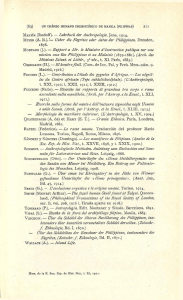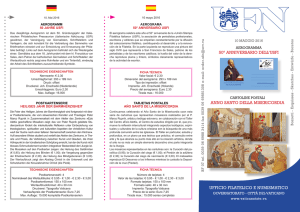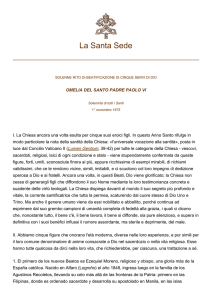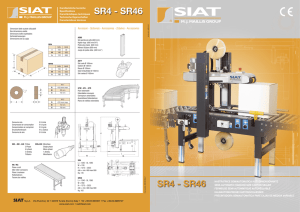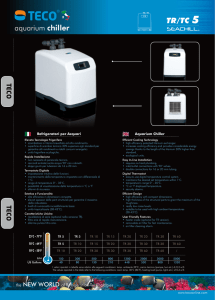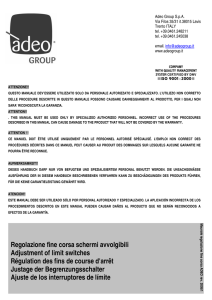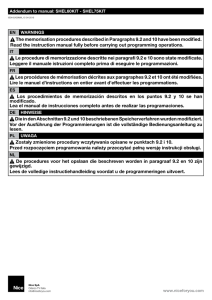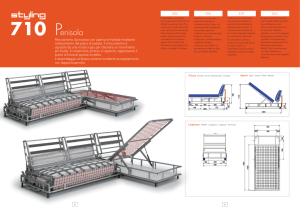Istruzioni ed avvertenze per l`installatore Instructions et
Anuncio
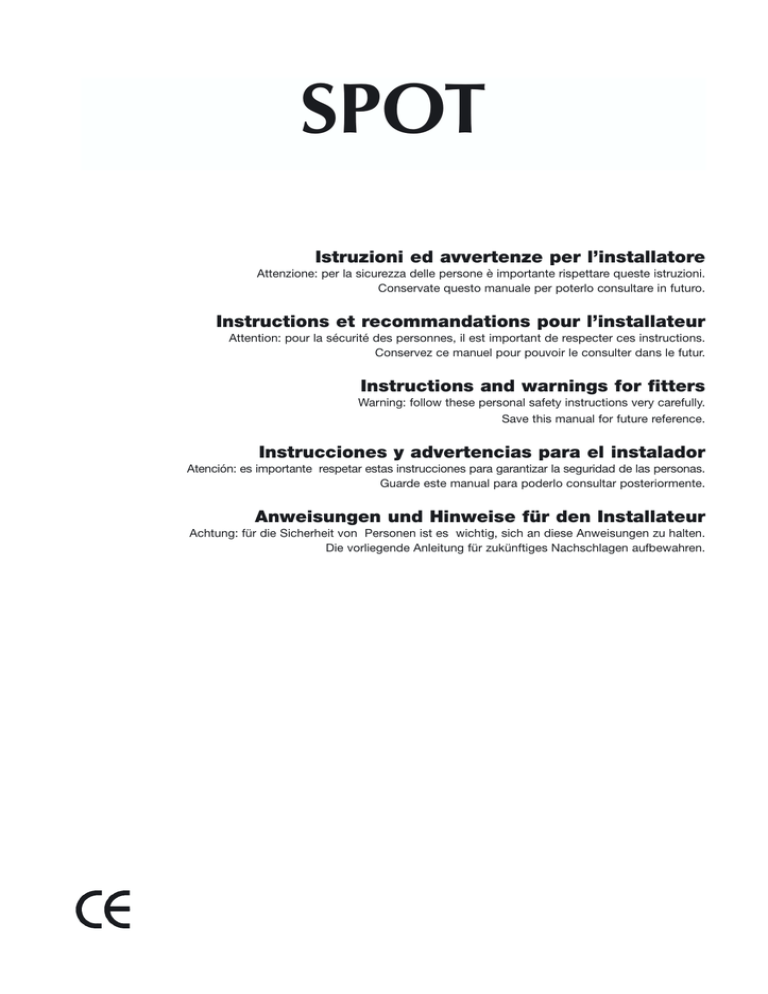
SPOT Istruzioni ed avvertenze per l’installatore Attenzione: per la sicurezza delle persone è importante rispettare queste istruzioni. Conservate questo manuale per poterlo consultare in futuro. Instructions et recommandations pour l’installateur Attention: pour la sécurité des personnes, il est important de respecter ces instructions. Conservez ce manuel pour pouvoir le consulter dans le futur. Instructions and warnings for fitters Warning: follow these personal safety instructions very carefully. Save this manual for future reference. Instrucciones y advertencias para el instalador Atención: es importante respetar estas instrucciones para garantizar la seguridad de las personas. Guarde este manual para poderlo consultar posteriormente. Anweisungen und Hinweise für den Installateur Achtung: für die Sicherheit von Personen ist es wichtig, sich an diese Anweisungen zu halten. Die vorliegende Anleitung für zukünftiges Nachschlagen aufbewahren. SPOT- Centrale da esterno per tende da sole e tapparelle I SPOT ISTRUZIONI PER L’INSTALLAZIONE, USO E MANUTENZIONE ATTENZIONE Prima di procedere all’installazione e alla programmazione della centralina leggere attentamente le istruzioni. Seguire scrupolosamente le indicazioni riportate. Una non corretta installazione può provocare gravi rischi. Il costruttore declina ogni responsabilità nel caso di non corretta installazione o d’uso improprio del prodotto. SOMMARIO 1. DESCRIZIONE DEL PRODOTTO 2. MEMORIZZAZIONE DEL RADIOCOMANDO MADRE E LOGICA DI FUNZIONAMENTO 3. AGGIUNTA DI NUOVI RADIOCOMANDI (TX2 - TX4 - TXP - TXMULTI - TXMULTI plus) 4. LOGICA DI FUNZIONAMENTO DEL PULSANTE ESTERNO DI COMANDO 5. PROGRAMMAZIONE DI UN RADIOCOMANDO “GLOBALE” (TX2 - TX4 - TXP - TXMULTI TXMULTI plus) 6 CANCELLAZIONE DEI CODICI DEI RADIOCOMANDI 7. INSTALLAZIONE DELL’ANEMOMETRO WINDY 8. PROGRAMMAZIONE DELLA VELOCITÀ DI INTERVENTO DELL’ANEMOMETRO 9. INVERSIONE DEL SENSO DI MARCIA 10. AVVERTENZE PER L’INSTALLAZIONE 11. CARATTERISTICHE TECNICHE 12. SCHEMA DEI COLLEGAMENTI ELETTRICI 13. SEGNALAZIONI IN PROGRAMMAZIONE 1. DESCRIZIONE DEL PRODOTTO La centralina “SPOT” è un sistema di automazione per tende e tapparelle dotato di scheda elettronica radioricevente supereterodina incorporata; il dispositivo è comandato da radiocomandi funzionanti nella banda di frequenza 433,92 MHz. 2. MEMORIZZAZIONE DEL RADIOCOMANDO MADRE E LOGICA DI FUNZIONAMENTO Il primo radiocomando che viene memorizzato è definito “MADRE” ed acquisisce automaticamente le seguenti caratteristiche: - Determina il verso di azionamento della tenda da sole/tapparella in base al tasto utilizzato durante la fase di memorizzazione. - É l’unico radiocomando che può attivare la fase di programmazione. Se durante la fase di memorizzazione del radiocomando MADRE, fossero presenti ulteriori centraline SPOT sulle quali ancora non è stato memorizzato il radiocomando madre, è opportuno scollegare quest’ultime dalla rete di alimentazione, in modo da evitare che più centraline memorizzino lo stesso radiocomando MADRE. Nel caso in cui si desideri invertire la logica di funzionamento dei tasti del radiocomando “MADRE” seguire le istruzioni a paragrafo 9. Per memorizzare il radiocomando “MADRE” procedere come illustrato di seguito. 2 SPOT I 1. Alimentare la centralina; 2. Premere e mantenere premuti ambedue i tasti del radiocomando finché il motoriduttore non segnalerà tramite due movimenti brevi sulla tenda/tapparella, uno di salita e l’altro di discesa, l’entrata in programmazione. 3. Premere il tasto del radiocomando “MADRE” da memorizzare; a questo punto la centralina memorizza il radiocomando “MADRE” ed esce automaticamente dallo stato di programmazione. La pressione del tasto “UP” del radiocomando permetterà l’alzata della taparella, viceversa, il tasto “DOWN” permette l’abbassamento. Durante la corsa, la pressione del tasto opposto al movimento causerà lo “STOP” della tenda (o tapparella): dalla posizione di riposo premendo il tasto “UP” la tapparella si alza, una nuova pressione del suddetto tasto non causerà alcunché e la tapparella continuerà nella sua corsa, invece pigiando il tasto “DOWN” la tenda si arresta; viceversa per la corsa in discesa. FIG.2 3. AGGIUNTA DI NUOVI RADIOCOMANDI(TX2 - TX4 - TXP - TXMULTI - TXMULTI plus) La centralina elettronica “SPOT” è in grado di memorizzare altri venti radiocomandi oltre al “MADRE”. Qualora si desideri memorizzare ulteriori radiocomandi occorre procedere come illustrato in seguito: 1. Alimentare la centralina; 2. Premere e mantenere premuti ambedue i tasti del radiocomando “MADRE” finché il motoriduttore non segnalerà, tramite due movimenti brevi della tenda/tapparella, uno di salita e l’altro di discesa, l’entrata in programmazione1; 3. Premere un tasto del nuovo radiocomando da memorizzare; a questo punto la centralina memorizza il nuovo radiocomando ed esce automaticamente dallo stato di programmazione. 1 L’entrata in programmazione è possibile solo attraverso il radiocomando “MADRE”. 3 Qualora si volessero memorizzare ulteriori radiocomandi procedere dal punto 2; qualora si tentasse di memorizzare più di venti radiocomandi (escluso il “MADRE”) la centralina provvederà alla cancellazione del primo radiocomando memorizzato e così di seguito per ulteriori nuovi radiocomandi, vedi fig. 3. I SPOT V Z FIG.3 4. LOGICA DI FUNZIONAMENTO DEL PULSANTE ESTERNO DI COMANDO E’ possibile installare un pulsante opzionale esterno (bassa tensione 24 V d.c.) di comando da parete per la movimentazione della tenda anche senza l’uso del radiocomando. La logica di funzionamento è di tipo passo-passo: ad ogni pressione del pulsante il motoriduttore esegue in modo sequenziale i comandi di salita, stop, discesa, stop. Il pulsante esterno di comando dovrà essere collegato ai cavi colore rosso e nero; per l’installazione vedere schema dei collegamenti elettrici al paragrafo 12. 5. PROGRAMMAZIONE DI UN RADIOCOMANDO “GLOBALE” (TX2 - TX4 - TXP - TXMULTI TXMULTI plus) In un installazione con più tende motorizzate può nascere l’esigenza di avere un unico radiocomando, denominato “GLOBALE”, vedi fig. 4, in grado di forzare l’apertura o la chiusura contemporanea di tutte o di un gruppo di tende (o tapparelle). Prima di procedere alla memorizzazione di un RADIOCOMANDO “GLOBALE” su ogni centralina è necessario che tutti i “MADRE” siano concordi nel verso di movimentazione della tenda (o tapparella), ovvero che abbiano tutti il tasto UP per che effettui la salita e il DOWN per la discesa. Procedere alla memorizzazione del RADIOCOMANDO “GLOBALE” nel modo indicato nel paragrafo 3 per tutte le tende da movimentare. FIG.4 4 SPOT 7. INSTALLAZIONE DELL’ANEMOMETRO WINDY Un eventuale eccesso di vento può danneggiare la struttura portante della tenda e la tenda stessa, per ovviare a ciò, la centralina “SPOT” è predisposta per l’installazione di un anemometro. L’anemometro va installato nei pressi della tenda ben esposto al vento, e collegato ai cavi di colore rosso e bianco, per i collegamenti vedi fig. 6 paragrafo 12. La soglia dell’intervento dell’anemometro è impostata a 15 Km/h . N.B. L’intervento dell’anemometro causa l’inibizione del funzionamento del radiocomando e del pulsante esterno per circa 8 minuti. Attenzione ! verificare che l’intervento dell’anemometro faccia compiere effettivamente la corsa di chiusura della tenda, se cosi non fosse, invertire il senso di marcia ( vedi par. 9 ) oppure invertire le fasi di alimentazione del motore (nero e marrone vedi fig.6) I 6. CANCELLAZIONE DEI CODICI DEI RADIOCOMANDI (compreso il “MADRE”) Può nascere la necessità di cancellare tutti i codici dei radiocomandi memorizzati, compreso il ”MADRE” (nel caso di smarrimento); a tal proposito premere e tener premuto il pulsante esterno (in posizione di stop) finché la centralina non segnala, attraverso tre brevi cicli consecutivi di “SALITA” e “DISCESA” della tenda (o tapparella), l’avvenuta cancellazione dei codici. In assenza di pulsante esterno questa procedura può essere eseguita simulando l’azionamento del pulsante mettendo a contatto i cavi di colore rosso e nero (comando a bassa tensione vedi par. 12). Si ricorda che nella successiva fase di memorizzazione di nuovi codici, il primo radiocomando memorizzato sarà codificato e riconosciuto dalla centralina come il nuovo “MADRE”. Per la memorizzazione del nuovo radiocomando madre seguire procedura indicata nel paragrafo 2. 8. PROGRAMMAZIONE DELLA VELOCITA’ DI INTERVENTO DELL’ANEMOMETRO. La Spot permette di impostare la velocità di intervento dell’anemometro (15 Km/h o 30 Km/h) agendo esclusivamente sul radiocomando “MADRE”. Per effettuare la programmazione procedere come segue: 1) Alimentare la “Spot”; 2) Premere e mantenere premuti ambedue i tasti del radiocomando “MADRE” finchè il motoriduttore non segnalerà, tramite due movimenti brevi della tenda, uno di apertura e chiusura, l’entrata in programmazione; 3) Premere un tasto qualsiasi del radiocomando “MADRE”: Il motoriduttore segnalerà lo stato attuale di impostazione della velocità di intervento dell’anemometro nel seguente modo: • un movimento breve del motoriduttore nei due sensi (apertura/chiusura) 15Km/h • 2 movimenti brevi del motoriduttore nei due sensi (apertura/chiusura/apertura/chiusura) 30Km/h 4) A questo punto se si desidera variare la velocità di soglia premere un tasto qualsiasi del radiocomando “MADRE”: ad ogni pressione del tasto il motoriduttore segnalerà (come indicato al punto 3) lo stato di impostazione della velocità di soglia. 5) Impostata la velocità desiderata sarà sufficiente far trascorrere circa 15s, senza effettuare alcuna operazione, per uscire dalla programmazione. N.B.! Nel caso di smarrimento del radiocomando madre per effettuare la programmazione della velocità di soglia è necessario cancellare i codici in memoria e rimemorizzare il radiocomando madre (seguire le indicazioni del paragrafo 6). 9. INVERSIONE DEL SENSO DI MARCIA Può nascere l’esigenza di invertire il senso di marcia, per far si che il tasto UP faccia effettivamente la salita. Per invertire il senso di rotazione premere e tener premuti entrambi i tasti del radiocomando “MADRE”, la centrale segnala, tramite due movimenti brevi della tenda (o tapparella), uno di salita e l’altro di discesa, l’entrata in programmazione; a questo punto premere il pulsante esterno (rosso/nero); l’avvenuta inversione è segnalata dalla centralina tramite due brevi movimenti di “SALITA” e due di “DISCESA” della tenda (o tapparella). 10. AVVERTENZE PER L’INSTALLAZIONE • La centralina SPOT deve essere installata unicamente da personale qualificato ed utilizzata solamente per movimentare motoriduttori tubolari per tende o tapparelle. 5 I SPOT • L’installatore deve provvedere alla protezione del dispositivo per mezzo di interruttore magnetotermico differenziale (con separazione tra i contatti di almeno 3 mm) che assicuri il sezionamento onnipolare dalla rete elettrica in caso di guasto. • Il cablaggio fornito unitamente al dispositivo deve essere sostituito, in caso di guasto, dal costruttore o da personale qualificato. 11. CARATTERISTICHE TECNICHE Alimentazione: 230 V a.c. Portata contatti relè: 5 A Sensibilità ricevitore: -105 dBm per S/N = 17 dB con modulazione portante 100% Alimentazione pulsante esterno: 24 V d.c. Tempo motore: 120 s Il costruttore dichiara che la SPOT è conforme alla direttiva 99/05 e che sono state applicate le normative riportate in tabella: Sicurezza elettrica Compatibilità elettromagnetica Uso efficace dello spettro EN 60335 I ETS 300 683 EN 300 220-3 12. SCHEMA DEI COLLEGAMENTI ELETTRICI 13. SEGNALAZIONI IN PROGRAMMAZIONE LA SPOT SEGNALA ATTRAVERSO IL MOVIMENTO DELLA TAPPARELLA LO STATO DI PROGRAMMAZIONE LA SPOT É IN ATTESA DI MEMORIZZARE UN NUOVO RADIOCOMANDO O DI INVERTIRE IL SENSO DI MARCIA LA SPOT SEGNALA L’AVVENUTA INVERSIONE DEL SENSO DI MARCIA (INSTALLAZIONE A SINISTRA) LA SPOT SEGNALA L’AVVENUTA CANCELLAZIONE DI TUTTI CODICI DEI RADIOCOMANDI 6 SPOT - Centrale d’extérieur pour stores et volets roulants ATTENTION Avant de procéder à l’installation et à la programmation de la centrale lire attentivement les instructions. Suivre scrupuleusement les indications reportées. Une installation incorrecte peut provoquer de graves risques. Le constructeur décline toute responsabilité en cas d’installation incorrecte ou de mauvaise utilisation du produit. SOMMAIRE 1. DESCRIPTION DU PRODUIT 2. MÉMORISATION DE LA RADIOCOMMANDE “MÈRE” ET LOGIQUE DE FONCTIONNEMENT 3. AJOUT DE NOUVELLES RADIOCOMMANDES (TX2 - TX4 - TXP - TXMULTI - TXMULTI plus) 4. LOGIQUE DE FONCTIONNEMENT DU BOUTON EXTERIEUR DE COMMANDE 5. PROGRAMMATION D’UNE RADIOCOMMANDE « GLOBAL » (TX2 - TX4 - TXP - TXMULTI TXMULTI plus) 6. ANNULLATION DES CODES RADIOCOMMANDES 7. INSTALLATION DE L’ANEMOMETRE WINDY 8. PROGRAMMATION DE LA VITESSE D’ENCLENCHEMENT DE L’ANEMOMETRE 9. INVERSION DU SENS DE ROULEMENT 10. AVERTISSEMENTS POUR L’INSTALLATION 11. CARACTERISTIQUES TECHNIQUES 12. SCHEMA DES MONTAGES ELECTRIQUES 13. SIGNALISATIONS EN PROGRAMMATION F SPOT INSTRUCTIONS POUR L’INSTALLATION, L’EMPLOI ET L’ENTRETIEN 1. DESCRIPTION DU PRODUIT La centrale « SPOT » est un système d’automatisation pour stores et volets roulants équipé de fiche électronique réceptrice superhèterodine incorporée; le dispositif est commandé par des radiocommandes qui fonctionnent sur la bande de fréquence 433,92 MHz. 2. MÉMORISATION DE LA RADIOCOMMANDE “MÈRE” ET LOGIQUE DE FONCTIONNEMENT La première radiocommande qui est mémorisée est définie “MÈRE” et acquiert automatiquement les caractéristiques suivantes : - elle détermine le sens d’ actionnement du volet roulant en fonction de la touche utilisée pendant la phase de mémorisation. - Elle est la seule télécomande qui peut activer la phase de programmation. Si, pendant la phase de mémorisation de la radiocommande mère, sont présentes des ultérieures centrales sur lesquelle: aucunee radiocommande n’a été mémorisée, il est conseillé de déconnecter ces dernièr du courant de façon à éviter que plusieurs centrales mémorisent la même radiocommande mère. Au cas où l’on désire inverser la logique du fonctionnement des touches de la radiocommande “MÈRE” , suivre les instructions a paragrafe 9. 7 F SPOT Pour mémoriser la radiocommande “MÈRE”, procéder comme illustré ci-dessous. 1. alimenter la centrale ; 2. passer et maintenir appuyées les deux touches de la radiocomande jusqu ‘à ce que le moteur signale, par deux mouvements brefs du volet, un en montée l’ autre en descente, l’entrée en programmation. 3. pousser la touche de la radiocommande “MÈRE” qu’il faut mémoriser ;maintenant la centrale a mémorisé la radiocommande “MÈRE” et sort automatiquement de la programmation. La pression du bouton « UP » de la radiocommande permettra l’ouverture du volet roulant, vice-versa, le bouton « Down » en permettra la fermeture. Durant la course, la pression du bouton opposé au mouvement causera le « STOP » (arrêt) du store (ou volet roulant) : de la position de repos, en pressant le bouton « UP », le volet s’ouvrira, une nouvelle pression sur le susmentionné bouton n’aura pas d’effets et le volet roulant continuera sa course, alors qu’en poussant le bouton « DOWN » le store s’arrêtera; vice-versa pour la course descendante. FIG.2 3. AJOUT DE NOUVELLES RADIOCOMMANDES (TX2 - TX4 - TXP - TXMULTI - TXMULTI plus) La centrale électronique « SPOT » est capable de mémoriser vingt autres radiocommandes en plus de « MÈRE ». Lorsque l’on désire mémoriser ulterieur radiocommandes procéder comme illustré ci dessous: 1. Alimenter la centrale; 2. Presser et maintenir pressés les deux boutons de la radiocommande « MÈRE » jusqu’à ce que le moto-réducteur signale l’entrée en programmation1, par deux mouvements brefs du store volets roulants, un d’ouverture et un de fermeture; 3. Presser un bouton de la nouvelle radiocommande que l’on veut mémoriser; la centrale mémorise alors la nouvelle radiocommande et sort automatiquement de l’état de programmation. 1 8 L’entrée en programmation est possible uniquement à travers la radiocommande « MÈRE ». F SPOT Au cas où l’on voudrait mémoriser d’autres radiocommandes, procéder à partir du point 2; au cas où l’on tenterait de mémoriser plus de sept radiocommandes (« MÈRE » excluse) la centrale s’occupera d’annuler la première radiocommande mémorisée et ainsi de suite pour les nouvelles radiocommandes supplémentaires, voir fig.3. FIG.3 4. LOGIQUE DE FONCTIONNEMENT DU BOUTON EXTERIEUR DE COMMANDE Il est possible d’installer un bouton de commande optionnel extérieur (basse tension 24 V d.c.) de paroi pour le déplacement du store même sans l’utilisation de la radiocommande. La logique de fonctionnement est du type pas à pas: à chaque pression du bouton, le moto-réducteur exécute de façon séquentielle les commandes d’ouverture, arrêt, fermeture, arrêt. Le bouton extérieur de commande devra être connecté aux câbles de couleurs rouge et noire; pour l’installation voir le schéma des montages électriques, paragraphe 12. 5. PROGRAMMATION D’UNE RADIOCOMMANDE « GLOBAL » (TX2 - TX4 - TXP - TXMULTI TXMULTI plus) Dans une installation comprenant plusieurs stores motorisés, on pourrait ressentir le besoin d’avoir un seul transmetteur portable, dénommé « GLOBALE », voir fig.4, capable de forcer en même temps l’ouverture ou la fermeture de tous ou d’un groupe de stores (ou volets roulants). Avant de procéder à la mémorisation d’un RADIOCOMMANDE « GLOBAL » sur chaque centrale il est nécessaire que toutes les RADIOCOMMANDE « MÈRE » soient synchrones dans le sens de déplacement du store (ou volet roulant), c’est-à-dire qu’à tous les boutons UP corresponde l’ouverture et qu’à tous les boutons DOWN la fermeture. RADIOCOMMANDE “GLOBAL” FIG.4 9 F SPOT Procéder à la mémorisation de la radiocommande « GLOBAL » selon les indications du paragraphe 3 pour tous les stores à activer. 6. ANNULATION DES CODES DES RADIOCOMMANDES (« MÈRE » incluse) On pourrait avoir besoin d’annuler tous les codes des radiocommandes mémorisées, inclus celui de « MÈRE » (en cas de perte); dans ce cas, presser et tenir pressé le bouton extérieur (en position d’arrêt) jusqu’à ce que la centrale signale l’effective annulation des codes, par trois cycles consécutifs brefs de « OUVERTURE » et « FERMETURE » du store (ou volet roulant). En l’absence de bouton poussoir externet cette procedure peut être éxécutée en simulant l’actionnement du boutton poussoir en mettant en contact les câbles de couleur rouge et noir (commande à basse tension v.c.f. part. 12). Nous vous rappelons que dans la phase successive de mémorisation de nouveaux codes, la première radiocommande mémorisée sera codifiée et reconnue par la centrale comme la nouvelle « MÈRE ». Pour mémoriser la nouvelle radiocommande mère, suivre la procédure indiquée au paragraphe 2. 7. INSTALLATION DE L’ANEMOMETRE WINDY Un éventuel excès de vent peut endommager la structure portante du store et le store lui-même, pour remédier à ce problème, la centrale « SPOT » est prédisposée à l’installation d’un anémomètre. L’anémomètre doit être installé près du store bien exposé au vent, et connecté aux câbles de couleurs Rouge et blanche, pour les montages électriques voir fig. 6 paragraphe 12. Le seuil d’intervention de l’anémomètre peut être positionné sur deux vitesses : 15 km/h ; N.B. L’INTERVENTION DE L’ANEMOMETRE CAUSE L’INHIBITION DU FONCTIONNEMENT DE LA RADIOCOMMANDE ET DU BOUTON EXTERIEUR PENDANT 8 MINUTES ENVIRON. Attention ! Vérifier que l’intervention de l’anémomètre fasse effectivement effectuer la course de fermeture du store. Si ce n’est pas le cas, invertir le sens de marche (cf. par. 9) dubien invertir les phases d’alimentation du moteu (noir et marron voir fig.6) 8. PROGRAMMATION DE LA VITESSE D’ENCLENCHEMENT DE L’ANEMOMETRE. L’appareil Spot permet de programmer la vitesse d’enclenchement de l’anémomètre (15 Km/h ou 30 Km/h) en agissant uniquement sur la radiocommande "MERE". La programmation s’effectue de la façon suivante: 1) Alimenter le "Spot"; 2) Appuyer, et rester appuyé sur les deux touches de la radiocommande " MERE " jusqu’à ce que le motoréducteur signale, par deux mouvements brefs du store, (l’un montant, l’autre descendant), le démarrage du mode programmation; 3) Appuyer sur n’importe quelle touche de la radiocommande "MERE ": Le motoréducteur va alors indiquer les paramètres actuels de vitesse d’enclenchement de l’anémomètre, de la façon suivante: • 1 mouvement bref du motoréducteur dans les deux sens (ouverture/fermeture); 15Km/h • 2 mouvements brefs du motoréducteur dans les deux sens (ouverture/fermeture/ouverture/fermeture); 30Km/h 4) A ce moment-là, il est possible de modifier la vitesse de seuil en appuyant sur n’importe quelle touche de la radiocommande " MERE " : à chaque pression de la touche, le motoréducteur indiquera (tel que décrit au point 3) les paramètres actuels de la vitesse de seuil. 5) Une fois la vitesse programmée, il suffit de laisser passer 30 secondes sans effectuer aucune opération pour quitter le mode programmation. N.B! Important! En cas de defaillance de la radiocommande “ mere”, la programmation de la vitesse de seuil s’effectue les codes memorises et en reprogrammant le memoire de la radiocommande “ mere “ (suivre les instruction du paragraphe 6) 9. INVERSION DU SENS DE ROULEMENT On pourrait avoir besoin d’inverser le sens de roulement de façon à ce que le bouton UP provoque effectivement l’ouverture. Pour inverser le sens de rotation presser et tenir pressés les deux boutons du radioguidage « MÈRE », la centrale signale l’entrée en programmation par deux mouvements brefs du store (ou volet roulant), un d’ouverture et l’autre de fermeture; presser alors le bouton extérieur (rouge/noir); l’effective inversion est signalée par la centrale par deux mouvements brefs de « OUVERTURE » et deux de « FERMETURE » du store (ou volet roulant). 10 11. CARACTERISTIQUES TECHNIQUES Alimentation : 230 V a.c. Portée contacts relais: 5 A Sensibilité récepteur: - 105 dBm pour S/N = 17 dB avec modulation porteuse 100% Alimentation bouton extérieur: 24 V d.c. Temps du moteur: 120 s F SPOT 10. AVERTISSEMENTS POUR L’INSTALLATION • La centrale SPOT doit être installée uniquement par du personnel qualifié et utilisée seulement pour activer des moto-réducteurs tubulaires pour stores ou volets roulants. • L’installateur doit faire le nécessaire pour la protection du dispositif à travers un interrupteur magnétothermique différentiel (avec séparation entre les contacts d’au moins 3 mm) qui assure le sectionnement omnipolaire du réseau électrique en cas de panne. • Le câblage fourni avec le dispositif doit être remplacé, en cas de panne, par le constructeur ou par du personnel qualifié. ACM déclare que SPOT est conforme à la directive 99/05 et que les normes reportées dans le tableau ont été appliquées: Securite electrique Compatibilite Electromagnetique Emploi efficacedu spectre EN 60335 I ETS 300 683 EN 300 220-3 12. SCHEMA DES MONTAGES ELECTRIQUES 13. SIGNALISATIONS EN PROGRAMMATION LE SPOT SIGNALE À TRAVERS LE MOUVEMENTDU VOLET L'ÉTAT DE LA PROGRAMMATION LE SPOT EST EN ATTENTE DE MÉMORISER UNE NOUVELLE RADIOCOMMANDE OU D'INVERSER LE SENS DE LA MARCHE LE SPOT SIGNALE L'INVERSION DU SENS DE LA MARCHE (INSTALLATION À GAUCHE) LE SPOT SIGNALE L'ANNULATION DE TOUS LES CODES DES RADIOCOMMANDES 11 SPOT - External central control unit for rolling shutter and awming GB SPOT INSTRUCTIONS FOR INSTALLATION, USE AND MAINTENANCE ATTENTION Read the instructions carefully before starting to install and programme the control unit. Follow the instructions scrupulously. Incorrect installation may create serious risks. The manufacturer declines all liability in the event of incorrect installation or improper use of the product. SUMMARY 1. DESCRIPTION OF THE PRODUCT 2. MOTHER RADIO CONTROL SWITCH MEMORISATION AND OPERATING LOGIC 3. ADDITION OF NEW RADIO CONTROL UNITS (TX2 - TX4 - TXP - TXMULTI - TXMULTI plus) 4. LOGIC OF FUNCTIONING OF THE CONTROL EXTERNAL PUSH BUTTON 5. PROGRAMMING OF A GLOBAL RADIO CONTROL SWITCH (TX2 - TX4 - TXP - TXMULTI - TXMULTI plus) 6. CANCELLATION OF RADIO CONTROL CODES 7. INSTALLATION OF THE ANEMOMETER WINDY 8. PROGRAMMING THE ANEMOMETER WINDY 9. INVERSION OF THE DIRECTION OF MOVEMENT 10. WARNINGS FOR INSTALLATION 11. TECHNICAL CHARACTERISTICS 12. ELECTRICAL CONNECTION DIAGRAM 13. INDICATORS UNDER DEVELOPMENT 1. DESCRIPTION OF THE PRODUCT The “SPOT” control unit is a system for automation of rolling shutter and awming with a radio receiver super-heterodyne electronic card incorporated. The device is controlled by radio control code working in the 433,92 MHz frequency band. 2. MOTHER RADIO CONTROL SWITCH MEMORISATION AND OPERATING LOGIC The first radio control switch to be memorised is known as the “MOTHER” and automatically acquires the following characteristics: - It establishes the roller window blind/awning direction of movement on the basis of the key used during the memorisation phase. - It is the only radio control switch able to activate the programming phase. If, memorising the mother radio control, are present other Spot central control on which no mother radio control is memorised, you should disconnect these central control from electrical alimentation to avoid that several control units memorize the same mother radio control. Follow the instructions provided on paragraph 9 if you wish to invert the operating logic of the “MOTHER” radio control keys. Proceed as follows to memorise the “MOTHER” radio control switch. 12 GB SPOT 1. Connect the control unit to the power supply; 2. Press and hold down both buttons of the radio control until two brief movements of the blind/awning (one up and one down) are observed. This indicates that Spot is in programming mode. 3. Press a key on the “MOTHER” radio control switch to be memorised. At this point the Spot memorises the “MOTHER” radio control switch and automatically exits from programming mode. Pressing the “UP” button of the radio control unit raises the blind, whereas pressing the “DOWN” button lowers it. When the blind is moving, pressing the “STOP” button will halt movement of the blind. When the UP button is pressed in the resting position, the blind is raised. Pressing the same button again will have no effect and the blind will continue its run. On the other hand, if the DOWN button is pressed the blind stops. Vice versa for the down run. FIG.2 3. ADDITION OF NEW RADIO CONTROL UNITS (TX2 - TX4 - TXP - TXMULTI - TXMULTI plus) The “SPOT” electronic control unit can memorise other twenty radio commands in addition to the “MOTHER”. In case you wish to add new codes in the receiver, the following procedure must be followed. 1. Connect the control unit to the power supply; 2. Press and hold down both buttons of the “MOTHER” radio control unit until the motor control unit signals the start of programming1 through two brief movements of the blind roller shutters, one upwards and the other downwards. 3. Press a key on the new radio control unit to be memorised. At this point the central control unit memorises the new radio control unit and exits automatically from programming status. 1 Programming status can be entered only through the “MOTHER” radio control 13 If one wants to memorise additional radio control units, resume from point 2 above. If an attempt is made to memorise more than seven radio control units (in addition to the “MOTHER”) the control unit will cancel the first one memorised, and so on in sequence for further radio control units (see fig. 3). RADIO GB SPOT CONTROL CODE MOTHER NEW RADIO CONTROL CODE RADIO CONTROL CODE RADIO CONTROL CODE RADIO CONTROL CODE A B V G Z H FIG.3 4. LOGIC OF FUNCTIONING OF THE EXTERNAL CONTROL PUSH BUTTON It is possible to install an optional external wall-mounted push button (low voltage 24 V d.c.) to move the blind even without using the radio control unit. The logic of functioning is step by step. Every time the push-button is pressed, the motor reducer executes the Up, Stop, Down, Stop actions sequentially. The external push button must be connected to the red and black coloured wires. For its installation see the electrical connection diagram in paragraph 12. 5. PROGRAMMING OF A GLOBAL RADIO CONTROL SWITCH (TX2 - TX4 - TXP - TXMULTI TXMULTI plus) In an installation with a number of motorised blinds, there may be a need to have a single transmitter mobile, denominated “GLOBAL”, see fig. 4, that can force opening or closure of all the group of blinds simultaneously. Before proceeding to memorise a “GLOBAL” RADIO CONTROL CODE on each control unit, all the “MOTHER” RADIO CONTROL CODE must be coordinated for direction of movement of the blinds, that is, they must all have the UP key for movement up and DOWN for movement down. Proceed to memorise the “GLOBAL” RADIO CONTROL CODE in the way indicated in paragraph 3 for all the blinds to be moved. “GLOBAL” RADIO CONTROL CODE 14 FIG.4 7. INSTALLATION OF THE ANEMOMETER WINDY If the wind is too strong it may damage the bearing structure of the blind or the blind itself. To prevent that, the “SPOT” control unit has been prepared for installation of an anemometer. The anemometer is installed near the blind, well exposed to the wind, and connected to the red and white wires. For the electrical connections see fig. 6 paragraph 12. The anemometer intervention threshold can be set for 2 speeds; 15 kph. N.B. INTERVENTION BY THE ANEMOMETER INHIBITS OPERATION OF THE RADIO CONTROL UNIT AND OF THE EXTERNAL PUSH BUTTON FOR ABOUT 8 MINUTES. Warning! Verify that the intervention of the anemometer actually completes the closure run of the awnings, if this were not the case, invert the direction (see paragraph 2). GB SPOT 6. CANCELLATION OF RADIO CONTROL CODES It may become necessary to cancel all the radio command codes memorised, including the “MOTHER” (in case of loss). To do so, press and hold down the external push button (in stop position) until the central unit signals that the codes have been cancelled through three short consecutive UP and DOWN cycles of the blind. When the external push button is missing, the following procedure can be carried out by simulating the putting on of the push button, through the connection of the red and black cable (low tension commands, see paragraph 12). Remember that in the subsequent memorising of new codes, the first radio command will be coded and recognised by the central unit as the new “MOTHER”. For the memorizing procedure of the “Mother” Remote Control, please follow the method indicated in paragraph 9, or to invert the motor power supply cables (black and brown F.6) 8. PROGRAMMING THE ANEMOMETER’S TRIPPING SPEED Using the Spot, you can set the tripping speed of the anemometer (15 km/h or 30 km/h) simply by using the "MOTHER" radio control. Programming should be performed as follows: 1) Power the “Spot”; 2) Press and hold down both the keys on the “MOTHER” radio control until the gear motor (through two brief awming movements, one upwards and the other downwards), displays entry into programming mode; 3) Press any key on the “MOTHER” radio control; The gear motor will display the anemometer’s current tripping speed setting as follows: • a brief gear motor movements in each direction (opening/closing) 15 km/h • 2 brief gear motor movements in each direction (opening/closing/opening/closing) 30 km/h 4) At this point, if you wish to alter the tripping speed, press any button on the "MOTHER" radio control: Each time the key is pressed, the gear motor will show the tripping speed setting (as described in point 3). 5) Once the desired speed is set, in order to exit programming mode, simply wait approximately 30 seconds without performing any operations. N.B.! if the “mother” radio control is lost, in order to programme the tripping speed you will need to cancel the stored codes and re-programme the “mother” radio control (follow the instructions in paragraph 7). 9. INVERSION OF THE DIRECTION OF MOVEMENT A need to reverse the direction of movement may arise, to ensure that the UP key actually makes the blind move up. To invert the direction of rotation, press and hold down both keys of the “MOTHER” radio control. The central unit signals entry into programming status by two brief movements of the blind (one up and one down). At that point press the external push button (red/black). Inversion is signalled by the central unit by means of two brief movements of the blind, UP and DOWN. 10. WARNINGS FOR INSTALLATION • The SPOT central control unit must be installed only by qualified personnel and used only to operate tubular motor-reducers for sun or window roller blinds. 15 GB SPOT • The installer must provide for protection of the device by means of a differential magnetothermic breaker (with at least 3 mm distance between the contacts) that ensures separation of all poles from the mains in the event of a fault. • In the event of a fault, the wiring supplied with the device must be replaced by the manufacturer or by qualified personnel. 11. TECHNICAL CHARACTERISTICS Power supply: 230 V AC Relay contact rating: 5 A Receiver sensitivity – 105 dBm for S/N = 17 dB with carrier modulation 100%. Power supply to external push button: 24 V DC Motor working time: 120 s ACM declares the SPOT conforms to Directive 99/05 and that the standards shown in the table have been applied. Electrical safety Electromagnetic compatibility Efficacious use of the spectrum EN 60335 I ETS 300 683 EN 300 220-3 12. ELECTRICAL CONNECTION DIAGRAM 13. INDICATORS UNDER DEVELOPMENT SPOT INDICATES THE PROGRAMMING STATUS THROUGH THE MOVEMENT OF THE BLIND SPOT IS WAITING TO RECORD A NEW RADIO COMMAND OR TO REVERSE THE DIRECTION SPOT INDICATES THAT THE DIRECTION HAS BEEN REVERSED (INSTALLED TO THE LEFT) SPOT INDICATES THAT ALL RADIO COMMAND CODES HAVE CANCELLED 16 BEEN SPOT - Central externa para toldos y persianas ATENCIÓN Antes de proceder a la instalación y a la programación de la central, leer atentamente las instrucciones. Es imprescindible seguir rigurosamente las indicaciones expresadas. Una instalación incorrecta puede provocar graves riesgos. El constructor declina toda responsabilidad en caso de instalación incorrecta o de uso impropio del producto. INDICE 1. DESCRIPCIÓN DEL PRODUCTO 2. MEMORIZACIÓN DEL MANDO A DISTANCIA MADRE Y LÓGICA DE FUNCIONAMIENTO 3. ADICIÓN DE NUEVOS MANDOS A DISTANCIA (TX2 - TX4 - TXP - TXMULTI - TXMULTI plus) 4. LÓGICA DE FUNCIONAMIENTO DEL PULSADOR EXTERNO DE MANDO 5. PROGRAMACIÓN DE UN MANDO “GLOBAL” (TX2 - TX4 - TXP - TXMULTI - TXMULTI plus) 6. CANCELACIÓN DE LOS CÓDIGOS DE MANDO A DISTANCIA 7. INSTALACIÓN DEL ANEMÓMETRO “WINDY” 8. PROGRAMMACIÓN DE LA VELOCIDAD DE INTERVENCIÓN DEL ANEMÓMETRO 9. INVERSIÓN DEL SENTIDO DE MARCHA 10. ADVERTENCIAS DE INSTALACIÓN 11. CARACTERÍSTICAS TÉCNICAS 12. ESQUEMA DE LAS CONEXIONES ELÉCTRICAS 13. SEÑALIZACIONES EN PROGRAMACIÓN E SPOT INSTRUCCIONES PARA LA INSTALACIÓN, USO Y MANTENIMIENTO 1. DESCRIPCIÓN DEL PRODUCTO La central “SPOT” es un sistema de motorización para toldos y persianas dotado de una placa electrónica radio-receptora superheterodina incorporada; el dispositivo es accionado mando a distancia que trabajan en la banda de frecuencia 433,92 MHZ. 2. MEMORIZACIÓN DEL MANDO A DISTANCIA MADRE Y LÓGICA DE FUNCIONAMIENTO El primer mando a distancia que se memoriza se denomina “MADRE” y adquiere automáticamente las siguientes características: - Determina el sentido de accionamiento del toldo/persiana según la tecla utilizada durante la memorización. - Es el único mando a distancia que puede activar la fase de programación. Si durante la fase de memorización del mando a distancia Ilamado “madre”, hubieran presentes mas centrales SPOT en las cuales no hay todavía memorizado el mando a distancia”madre”, es oportuno desconectar estos últimos de la red de alimentación , en modo de evitar que mas de centrales memoricen el mismo mando a distancia“madre”. Si se desea invertir la lógica de funcionamiento de las teclas del mando a distancia “MADRE”, seguir las instrucciones a apartado 9. Para memorizar el mando a distancia “MADRE”, proceder como se indica a continuación. 17 E SPOT 1. Cargar la central; 2. Pulsar las dos teclas del mando y no soltarlas hasta que el motorreductor indique, con dos breves movimientos de subida y bajada del toldo/persiana, que ha entrado en fase de programación. 3. Pulsar la tecla del mando a distancia “MADRE” que se desea memorizar; hecho esto, la central memoriza el mando a distancia “MADRE” y sale automáticamente del estado de programación. Pulsando el botón “UP” del mando a distancia se activa el mecanismo de subida de la persiana y viceversa pulsando el botón “DOWN” se activa el mecanismo de bajada. Si durante el recorrido de la persiana se presiona el pulsador contrario al movimiento en ejecución, se obtendrá el “PARO-STOP” del toldo (o persiana): partiendo de la posición de reposo con el pulsador “UP” la persiana se levanta, presionando nuevamente este mismo pulsador nada ocurrirá y la persiana seguirá su recorrido, al contrario presionando el pulsador “DOWN” se obtendrá el paro de la persiana; viceversa para el recorrido en bajada. FIG.2 3. ADICIÓN DE NUEVOS MANDOS A DISTANCIA (TX2 - TX4 - TXP - TXMULTI - TXMULTI plus) La central electrónica SPOT puede memorizar otros veinté mandos a distancia además del mando “MADRE”. En el caso de que se desee memorizar otros mando, proceder como indicado a continuación: 1. Cargar la central; 2. Presionar y tener presionados ambos pulsadores del mando a distancia “MADRE” hasta que el motorreductor indique, a través de dos pequeños movimientos del toldo persiana, uno de subida y el otro de bajada, la entrada en programación1; 3. Presionar un pulsador del nuevo mando a distancia que desea memorizar; la central memoriza el nuevo mando a distancia y sale automáticamente del estado de programación. 1 18 La entrada en programación es posible únicamente a través del mando a distancia “MADRE”. E SPOT En el caso de querer memorizar más de un mando a distancia, proceder a partir del punto 2; si se tratan de memorizar más de siete mandos (excepto el mando “MADRE”) la central eliminará el primer mando a distancia memorizado y así en adelante para los nuevos mandos a distancia, véase fig. 3. FIG.3 4. LÓGICA DE FUNCIONAMIENTO DEL PULSADOR EXTERNO DE MANDO Es posible instalar un pulsador externo (baja tensión 24 V d.c.) de mando opcional de pared para el manejo del toldo sin utilizar el mando a distancia. La lógica de funcionamiento es del tipo paso a paso: cada vez que se presiona el pulsador el motorreductor realiza de manera secuencial el mando de subida, stop, bajada, stop. El pulsador externo de mando se deberá conectar a los cables de color rojo y negro; para la instalación ver el esquema de las conexiones eléctricas del párrafo 12. 5. PROGRAMACIÓN DE UN MANDO “GLOBAL” (TX2 - TX4 - TXP - TXMULTI - TXMULTI plus) En una instalación con varios toldos motorizados puede hacerse necesario tener un único transmisor portable, llamado “GLOBAL”, ver fig. 4, capaz de forzar la apertura o el cierre contemporáneo de todos o de un grupo de toldos (o de persianas). Antes de proceder a la memorización de un MANDO “GLOBAL” en cada Radiomatic es necesario que todos los MANDO “MADRE” estén de acuerdo sobre la dirección de movimiento del toldo (o persiana), es decir asegurarse de que el pulsador UP efectúa la subida y el pulsador DOWN efectúa la bajada. Proceder a la memorización del MANDO “GLOBAL” según las indicaciones del párrafo 3 para todos los toldos que se desea desplazar. MANDO “GLOBALE” FIG.4 19 E SPOT 6. CANCELACIÓN DE LOS CÓDIGOS DE MANDO A DISTANCIA (incluso el mando “MADRE”) Se puede hacer necesario cancelar todos los códigos de los mandos a distancia memorizados (incluso el mando “MADRE”) (en caso de extravio). Para tal efecto, presionar y tener presionado el pulsador externo (en posición de stop) hasta que la central indique, a través de tres pequeños ciclos consecutivos de “SUBIDA” y “BAJADA”, la cancelación de los códigos. Si falta el botón externo, este procedimiento puede llevarse a efecto simulando el accionamiento del botón para ello hay que hacer contacto entre los cables de color rojo y negro (mando de baja tensión, ver apartado 12). Se recuerda que en la posterior fase de memorización de nuevos códigos, el primer mando a distancia memorizado será codificado y reconocido por la central como el nuevo código “MADRE”. Para memorizar el nuevo radiocontrol madre,, seguir el procedimento indicado en el apartado 2. 7. INSTALACIÓN DEL ANEMÓMETRO WINDY Un eventual exceso de viento puede dañar la estructura portante del toldo y el mismo toldo. Para obviar estos inconvenientes, la central “Spot” está predispuesta para la instalación de un anemómetro. El anemómetro se deberá instalar cerca del toldo, en un lugar bien expuesto al viento, y deberá conectarse a los cables de color Rojo y Blanco; para las conexiones eléctricas véase fig. 6 párrafo 12. El nivel umbral del anemómetro puede regularse según dos velocidades: 15 km/h N.B. La acciòn del anemòmetro causa la inhibiciòn del funcionamiento del mando a distanzia y del pulsador externo por aproximadamente 8 minutos Atención !: Asegurarse de que la intervención del anemómetro permita completar efectivamente el recorrido de cierre del toldo, caso contrario, invertir el sentido de la marcha (ver apdo. 3) 8. PROGRAMACIÓN DE LA VELOCIDAD DE INTERVENCIÓN DEL ANEMÓMETRO. Spot permite programar la velocidad de intervención del anemómetro ( 15 Km/h o 30 Km/h) simplemente mediante el uso del radiocontrol “MADRE”. Para efectuar la programación, proceder como se indica a continuación: 1) Dar alimentación a "Spot"; 2) Pulsar las dos teclas del radiocontrol “MADRE” sin soltarlas hasta que el motorreductor señale, con dos breves movimientos de toldo (uno de subida y otro de bajada), que ha entrado en fase de programación; 3) Pulsar cualquiera de las teclas del radiocontrol “MADRE”: El motorreductor señalará el estado actual de programación de la velocidad de intervención del anemómetro de la siguiente manera: • un movimiento breve del motorreductor en ambos sentidos (abertura/cierre) 15Km/h • 2 movimientos breves del motorreductor en ambos sentidos (abertura/cierre/abertura/cierre) 30Km/h 4) Hecho esto, si se desea cambiar la velocidad de umbral, pulsar una tecla cualquiera del radiocontrol “MADRE”: cada vez que se pulsa la tecla, el motorreductor señalará (como se indica en el punto 3) el estado de programación de la velocidad de umbral. 5) Una vez establecida la velocidad deseada, basta con dejar pasar unos 30 s sin efectuar operación alguna para salir de la fase de programación. NOTA: en caso de extravío del radiocontrol “madre”, para efectuar la programación de la velocidad de umbral es necesario cancelar los códigos memorizados y rememorizar el radiocontrol “madre” (seguir las indicaciones del apdo. 6). 9. INVERSIÓN DEL SENTIDO DE MARCHA Puede hacerse necesario invertir el sentido de marcha de manera que el pulsador UP accione efectivamente el movimiento de subida. Para invertir el sentido de rotación presionar y tener presionados ambos pulsadores del mando a distancia “MADRE”, la central indica, a través de dos pequeños movimientos del toldo (o persiana), uno de subida y el otro de bajada, la entrada en programación; luego presionar el pulsador externo (rojo/negro). La central indica con dos movimientos de “SUBIDA” del toldo (o de la persiana) y dos de “BAJADA” que se ha llevado a cabo la inversión. 20 11. CARACTERÍSTICAS TÉCNICAS Alimentación: 230 V a.c. Carga contactos relés: 5 A Sensibilidad receptor: -105dBm para S/N = 17dB con modulación portadora 100% Alimentación pulsador externo: 24 V d.c. Tiempo de funcionamiento motor: 120s E SPOT 10. ADVERTENCIAS DE INSTALACIÓN • La central “SPOT” deberá ser instalada únicamente por personal calificado y utilizada solamente para desplazar motorreductores tubulares para toldos o persianas. • El instalador se ocupará de disponer la protección del dispositivo mediante un interruptor magnetotérmico diferencial (con distancia entre los contactos de mínimo 3mm) que asegure el corte omnipolar de la instalación eléctrica en caso de avería. • El cableado suministrado junto con el dispositivo deber ser remplazado, en caso de avería, por el constructor o por personal calificado. ACM declara que SPOT cumple con lo dispuesto en la directiva 99/05 y que se han aplicado las normas indicadas en la siguiente tabla: Seguridad eléctrica Compatibilidad electromagnética Uso eficaz del espectro EN 60335 I ETS 300 683 EN 300 220-3 12. ESQUEMA DE LAS CONEXIONES ELÉCTRICAS 13. SEÑALIZACIONES EN PROGRAMACIÓN EL SPOT SEÑALA, A TRAVÉS DEL MOVIMENTO DE LA PERSIANA, EL ESTADO DE PROGRAMACIÓN EL SPOT ESTÁ EN ESPERA DE MEMORIZAR UN NUEVO MANDO A DISTANCIA O DE INVERTIR EL SENTIDO DE LA MARCHA. EL SPOT SEÑALA LA INVERSIÓN DEL SENTIDO DE LA MARCHA (INSTALACIÓN A LA IZQUIERDA) EL SPOT SEÑALA LA CANCELACIÓN DE TODOS LOS CÓDIGOS DE LOS MANDOS A DISTANCIA. 21 SPOT - Externes Steuerungsgehäuse für Sonnen-markisen und Rollläden D SPOT ANLEITUNG ZUR INSTALLATION, ZUM GEBRAUCH UND ZUR WARTUNG ACHTUNG Vor dem Installieren des Steuerungsgehäuses die Gebrauchsanweisung aufmerksam durchlesen. Die aufgeführten Anweisungen genauestens befolgen. Eine fehlerhaft durchgeführte Installation kann schwere Risiken verursachen. Der Hersteller lehnt jegliche Verantwortung im Falle einer fehlerhaften Installation bzw. eines ungeeigneten Gebrauchs des Produktes ab. INHALTSVERZEICHNIS 1. BESCHREIBUNG DES PRODUKTS 2. SPEICHERUNG DER FUNKSTEUERUNG “MUTTER” UND FUNKTIONSLOGIK 3. ZUSÄTZLICHE NEUE FUNKSTEUERUNGEN (TX2 - TX4 - TXP - TXMULTI - TXMULTI plus) 4. FUNKTIONSLOGIK DES EXTERNEN DRUCKKNOPFS 5. PROGRAMMIERUNG EINES FUNKSTEUERUNG-SCODES „GLOBAL“ (TX2 - TX4 - TXP TXMULTI - TXMULTI plus) 6. LÖSCHEN DER FUNKSTEUERUNG-SCODES 7. INSTALLATION DES WINDGESCHWINDIGKEITSMESSERS „WINDY” 8. PROGRAMMIERUNG DER EINGRIFFSGESCHWINDIGKEIT DES ANEMOMETERS. 9. UMKEHR DER BETRIEBSRICHTUNG 10. ANWEISUNGEN ZUR INSTALLATION 11. TECHNISCHE EIGENSCHAFTEN 12. SCHEMA DER ELEKTRISCHEN VERBINDUNGEN 13. ANGABEN IN DER PROGRAMMIERUNGSPHASE 1. BESCHREIBUNG DES PRODUKTS Bei dem Steuerungsgehäuse „SPOT“ handelt es sich um ein System der Automatisierung für Markisen und Rollläden, die mit einer eingebauten elektronischen uberlangerungsfang Karte für den Funkempfang ausgestattet sind. Die Vorrichtung wird von in dem Frequenzband 433,92 MHz funktionierenden Funksendern gesteuert. ABB.1 2. SPEICHERUNG DER FUNKSTEUERUNG “MUTTER” UND FUNKTIONSLOGIK Die erste gespeicherte Funksteuerung wird als “MUTTER” bezeichnet und nimmt automatisch die folgenden Eigenschaften an: - Sie bestimmt je nach der Taste, die während der Speicherungsphase benutzt wurde, die Betriebsrichtung der Markisen/Rollläden. - Sie ist die einzige Funksteuerung, die die Programmierphase aktivieren kann. Wenn beim speichern von die funksteurung “MUTTER”, genannt, wo noch nicht die funksteurung “MUTTER”, gespeichert wurde, war es nötig diese von der stromversorgung zu abbrechen. Man kann so vermeiden dass mehrere steuerungsgehäuse die selbe funksteurung “MUTTER” speichern. Sofern Sie die Funktionslogik der Tasten der Funksteuerung “MUTTER” umkehren möchten, müssen Sie die Anweisungen des Abschnittes 9 befolgen. 22 D SPOT Zur Speicherung der Funksteuerung “MUTTER”, gehen Sie wie folgend angezeigt vor. 1. Dem Steuerungsgehäuse Strom zuführen; 2. Die Tasten der Funksteuerung betätigen und so lange gedrückt halten, bis der Getriebemotor mittels zweier kurzer Bewegungen der Markise/des Rollladens, einmal kurz hinauf und einmal kurz hinunter, signalisiert, dass die Programmierung erfolgreich abgeschlossen wurde. 3. Die Taste der zu speichernden Funksteuerung “MUTTER” betätigen. Jetzt speichert das Steuerungsgehäuse die Funksteuerung “MUTTER” und verlässt automatisch den Programmierungsmodus Durch Betätigen der Taste „UP“ der Funksteuerung fährt der Rollladen hoch, und umgekehrt ist es möglich, den Rollladen durch Drücken der Taste „DOWN“ herunterzulassen. Durch Betätigen des entgegengesetzten Druckknopfes während des Hinauffahrens hält der Rollladen (oder die Sonnenmarkise) an. Der Rollladen verlässt seine Ruheposition und fährt weiter hoch, sobald die Taste „UP“ betätigt wird. Ein erneutes Betätigen der oben genannten Taste führt dazu, dass der Rollladen weiter hinauffährt. Wird hingegen die Taste „DOWN“ betätigt, hält der Rollladen an. Umgekehrtes gilt für das Hinunterlassen des Rollladens. ABB.2 3. ZUSÄTZLICHE NEUE FUNKSTEUERUNGEN (TX2 - TX4 - TXP - TXMULTI - TXMULTI plus) Das elektronische Steuerungsgehäuse „SPOT“ ist in der Lage, außer der „MUTTER“ weitere sieben Funksteuerungen zu speichern. Zum Speichern zusädliche funksteue- rungen TX2-Steuerungen wie folgt vorgehen: 1. Dem Steuergehäuse Strom zuführen; 2. Die beiden Tasten der “MUTTER“-Funksteuerung betätigen und so lange gedrückt halten, bis der Getriebemotor mittels zweier kurzer Bewegungen der Markise, rolläden (einmal kurz hinauf und einmal kurz hinunter) signalisiert, dass die Programmierung1 erfolgreich abgeschlossen wurde. 3. Eine Taste der neuen zu speichernden Funksteuerung betätigen. Jetzt speichert das Steuerungsgehäuse die neue Funksteuerung und verlässt automatisch den Programmierungsmodus. 1 Die Programmierung ist nur mittels der Funksteuerung „MUTTER“ möglich. 23 D SPOT Wenn weitere Funksteuerungen gespeichert werden sollen, muss die Vorgehensweise ab Punkt 2 wiederholt werden. Sollte versucht werden, mehr als sieben Funksteuerungen (außer der „MUTTER“) zu speichern, löscht das Steuerungsgehäuse die erste gespeicherte Funksteuerung und geht bei allen weiteren Versuchen, Funksteuerungen zu speichern, in derselben Art und Weise vor. Siehe Abb. 3. ABB.3 4. FUNKTIONSLOGIK DES EXTERNEN DRUCKKNOPFS ZUM STEURUNG Es ist optionsweise möglich, einen externen Druckknopf (Niederspannung, 24 V DC) zur Steuerung an der Wand zu installieren. Mit diesem Knopf kann die Markise auch ohne Funksteuerung bewegt werden. Bei der Funktionslogik handelt es sich um eine Logik, die schrittweise funktioniert. Bei jeder Betätigung des Druckknopfes führt der Getriebemotor die Steuerung der Befehle „AUF“, „STOPP“, „AB”, „STOPP“ sequentiell durch. Der externe Druckknopf zum steurung muss mit dem roten und dem schwarzen Kabel verbunden werden. Zum Durchführen dieser Installation, das Schema der elektrischen Verbindungen unter Absatz 12 betrachten. 5. PROGRAMMIERUNG EINES FUNKSTEUERUNG-SCODES „GLOBAL“ (TX2 - TX4 - TXP - TXMULTI - TXMULTI plus) Beim Installieren von mehr als einer motorisierten Markise kann es notwendig sein, über einen einzigen Funksender, der „GLOBAL“ genannt wird, zu verfügen (siehe Abb. 4), der in der Lage ist, das gleichzeitige Öffnen bzw. Schließen aller oder einer Gruppe von Markisen (oder Rollläden) zu ermöglichen. Vor dem Speichern einer FUNKSTEUERUNGS CODE „GLOBAL“ an jedem SPOT-Steuerungsgehäuse ist es notwendig, dass sämtliche FUNKSTEUERUNGS CODE „MUTTERN“ in dieselbe Bewegungsrichtung der Markise (oder des Rollladens) eingestellt sind, bzw. dass bei allen Steuerungsgehäusen die Taste „UP“ gedrückt ist, falls das HINAUFFAHREN und „DOWN“, falls das HINUNTERLASSEN gewünscht ist. Zum Speichern der FUNKSTEUERUNGS CODE „GLOBAL“ für alle zu Markisen (oder Rollläden), die bewegt werden sollen, muss wie im Absatz 3 beschrieben wird, vorgegangen werden. FUNKSTEUERUNGS CODE “GLOBALE” 24 ABB.4 7. INSTALLATION DES WINDGESCHWINDIGKEITSMESSERS Ein zu starker Wind kann die tragende Struktur der Sonnenmarkise oder des Rollladens beschädigen. Aus diesem Grund ist das Steuerungsgehäuse „SPOT“ mit einer Vorrichtung zur Installation eines Windgeschwin-digkeitsmessers ausgestattet. Der Windgeschwindigkeitsmesser muss an jenen Teilen der Markise bzw. des Rollladens installiert werden, welche dem Wind am stärksten ausgesetzt sind und muss mit dem roten und dem weißen Kabel verbunden werden. Zu diesem Thema siehe Abb. 6 des Absatzes 12 (Schema der elektrischen Verbindungen). Die Interventionsschwelle des Windgeschwindigkeitsmessers kann mittels eines Jumpers, der im Inneren des Steuergehäuses angebracht wird, auf zwei Geschwindi-gkeiten eingestellt werden: 15 km/h. Achtung: das eingreifen des windgeschwindigkeitsmessers führt zu einer etwa 8 minuten dauern den funktionshemmung der funksteuerung und des externen druckknopfes. Achtung ! überprüfen sie, ob sich die wirkung des anemometers effektiv über den schließlauf der markise erstreckt, andernfalls ist die gangrichtung umzukehren (siehe paragraph 2) D SPOT 6. LÖSCHEN DER FUNKSTEUERUNGSCODES (inklusive der „MUTTER“) Es kann die Notwendigkeit bestehen, sämtliche zuvor gespeicherte Funksteuerungen, inklusive der „MUTTER“ (im verlust fall) zu löschen. Um diese Funktion durchzuführen, muss der externe (bei den HALT-Position) Druckknopf so lange gedrückt werden, bis das Steuerungsgehäuse mittels dreier kurzer aufeinander folgender „AUF“-oder „AB“-Zyklen der Markise (oder des Rollladens) die erfolgreich abgeschlossene Löschung anzeigt. Wenn der externe Wippschalter fehlt, kann man den selben Prozess simulieren, bzw. die Funktion des Wippschalters durch den Anschluss von den roten und schwarzen Kabel (Niederspannung Schaltung, Paragraph 12). Es wird daran erinnert, dass in einer darauf folgenden Phase der Speicherung neuer Codes, die erste gespeicherte Funksteuerung als „MUTTER“ gespeichert und vom Steuerungsgehäuse als solche kodifiziert wird. Die Speicherung des „MUTTER“ Handsender, bitte folgen sie die geeignete Methodologie an Paragraph 2. 8. PROGRAMMIERUNG DER EINGRIFFSGESCHWINDIGKEIT DES ANEMOMETERS. Der Spot ermöglicht die Einstellung der Eingriffsgeschwindigkeit des Anemometers (15 km/h oder 30 km/h) ausschließlich über die Funksteuerung "MADRE". Um die Programmierung durchzuführen, gehen Sie wie folgt vor: 1) Schalten Sie den "Spot" ein; 2) Drücken Sie beide Tasten der Funksteuerung "MADRE" und halten Sie sie gedrückt, bis der Getriebemotor durch zwei kurze Bewegungen des markise, eine nach oben und eine nach untern, die Programmierung bestätigt; 3) Drücken Sie eine beliebige Taste der Funksteuerung "MADRE": Der Getriebemotor zeigt die aktuelle Einstellung der Eingriffsgeschwindigkeit des Anemometers auf folgende Weise an: • eine kurze Bewegung des Getriebemotors in beide Richtungen (offnung/schlieben) 15 km/h • Zwei kurze Bewegungen des Getriebemotors in beide Richtungen (offnung/schlieben/offnung/schlieben) 30 km/h 4) Nun müssen Sie eine beliebige Taste der Funksteuerung "MADRE" drücken, wenn Sie die Grenzgeschwindigkeit ändern möchten: Mit jedem Tastendruck zeigt der Getriebemotor (wie in Punkt 3 dargestellt) die eingestellte Grenzgeschwindigkeit an. 5) Nach Einstellung der gewünschten Geschwindigkeit sollte man etwa 30 Sekunden warten, ohne weitere Einstellungen zu treffen, um die Programmierung zu verlassen. Achtung! falls die funksteuerung "madre" verloren wird, ist es nötig, die gespeicherten codes zu löschen und die funksteuerung "madre" neu zu speichern (folgen sie den anweisungen von kapitel 6), um die programmierung der grenzgeschwindigkeit durchzuführen. 9. UMKEHR DER BETRIEBSRICHTUNG Es kann die Notwendigkeit eintreten, die Betriebsrichtung umkehren zu müssen, damit die Taste „UP“ den Rollladen/die Markise tatsächlich hochfährt. Um die Rotationsrichtung umzukehren, müssen beide Tasten der Funksteuerung „MUTTER“ gleichzeitig betätigt und gedrückt gehalten werden. Das Steuerungsgehäuse signalisiert mittels zweier kurzer Bewegungen der Sonnenmarkise (oder des Rollladens) - einmal kurz hinauf und einmal kurz hinunter -, dass die Programmierung erfolgreich abge- 25 D SPOT schlossen wurde. Nun den externen Druckknopf betätigen (rot/schwarz). Die erfolgreich erfolgte Umkehrung wird von dem Steuerungsgehäuse mittels zweier kurzer Bewegungen – „AUF“ und „AB“ – der Sonnenmarkise (oder des Rollladens signalisiert). 10. ANWEISUNGEN ZUR INSTALLATION • Das Steuerungsgehäuse „SPOT“ darf ausschließlich von extra hierfür geschultem Fachpersonal installiert werden und nur darf nur dazu eingesetzt werden, um die Getriebemotoren für Markisen oder Rollläden zu bewegen. • Der Installateur muss dafür sorgen, dass die Vorrichtung mittels eines magnetthermischen Fehlerstromschutzschalters (zwischen den einzelnen Kontakten muss ein Abstand von mindestens 3 mm bestehen) geschützt wird, der im Falle eines Defektes eine allpolige Trennung vom elektrischen Netz gewährleistet. • Das mit der Vorrichtung gelieferte Kabel muss im Schadensfall vom Hersteller oder einer Fachkraft ausgetauscht werden. 12. TECHNISCHE EIGENSCHAFTEN Stromversorgung: 230 V AC Leistungsfähigkeit der Relaiskontakte: 5 A Empfindlichkeit des Empfängers: -105 dBm für S/N = 17 dB mit Trägermodulation von 100% Stromzufuhr externer Druckknopf: 24 V DC Arbeitszeit des Motors: 120 s Die Firma ACM erklärt hiermit, dass das Steuerungsgehäuse SPOT der Richtlinie 99/05 entspricht und dass die Richtlinien entsprechend der unten aufgeführten Tabelle angewandt wurden. Elektrische sicherheit Elktromagnetische kompatibilität Effizienter gebrauch des spektrums EN 60335 1 ETS 300 683 EN 300 220-3 12. SCHEMA DER ELEKTRISCHEN VERBINDUNGEN 13. ANGABEN IN DER PROGRAMMIERUNGSPHASE SPOT ZEIGT DEN PROGRAMMIERUNGSSTAND DURCH DIE BEWEGUNG DES ROLLLADENS AN SPOT WARTET AUF DIE SPEICHERUNG EINER NEUEN FUNKSTEUERUNG ODER DIE UMKEHRUNG DER FAHRTRICHTUNG. SPOT ZEIGT DIE TATSÄCHLICHE ABGESCHLOSSENE EINSCHALTUNG DER UMKEHRUNG DER FAHRTRICHTUNG AN (LINKS-EINRICHTUNG). SPOT ZEIGT DIE TATSÄCHLICHE ABGESCHLOSSENE LÖSCHUNG ALLER CODEZES DER FUNKSTEUERUNGEN AN 26 Rev. 2 del 20-9-07
